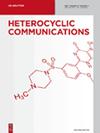重氮苯并噻唑离子与对乙酰氨基酚偶联反应新偶氮化合物的合成、断裂模式特征及抗菌活性
IF 1.5
3区 化学
Q3 CHEMISTRY, ORGANIC
引用次数: 1
摘要
摘要本研究以取代苯并噻唑衍生物为原料,经重氮化,再与对乙酰氨基酚偶氮偶联,合成了一系列偶氮苯并噻唑染料4。使用分析数据和光谱技术,包括紫外-可见光谱、红外光谱、质谱以及1H-和13C-NMR,确认了所有合成化合物的化学结构。原位形成的重氮苯并噻唑离子在Hollemann引导的亲电芳香取代机制中与对乙酰氨基酚衍生物区域特异性反应。一方面,通过对1H-NMR光谱的严格解释,另一方面,根据在电喷雾质谱上观察到的特征碎片模式,确定了区域取向。在4a和4b的情况下,发生了多重取代。研究了化合物4和所有起始材料对铜绿假单胞菌PA01、金黄色葡萄球菌18、大肠杆菌64R和金黄色葡萄杆菌ATCC 25923的抗菌活性。结果表明,该骨架作为抗菌剂表现出显著的效力。对两种目标生物最具活性的抗菌剂是化合物4a′。本文章由计算机程序翻译,如有差异,请以英文原文为准。
Synthesis, characteristic fragmentation patterns, and antibacterial activity of new azo compounds from the coupling reaction of diazobenzothiazole ions and acetaminophen
Abstract In this study, a series of azobenzothiazole dyes 4 were synthesized via diazotization of substituted benzothiazole derivatives followed by azo coupling with acetaminophen. The chemical structures of all synthesized compounds were confirmed using analytical data and spectroscopic techniques, including UV-visible, IR, mass spectra, and 1H- and 13C-NMR. The in situ formed diazobenzothiazole ions regiospecifically react with acetaminophen derivatives in the Hollemann-guided electrophilic aromatic substitution mechanism. The regio-orientations were established, on the one hand, by a rigorous interpretation of 1H-NMR spectra and, on the other hand, by the characteristic fragmentation patterns observed on the electrospray mass spectra. In the cases of 4a and 4b, multisubstitutions occurred. The antimicrobial activity of compound 4, along with all the starting materials, was investigated on Pseudomonas aeruginosa PA01, Staphylococcus aureus 18, Escherichia coli 64R, and S. aureus ATCC 25923. The results showed that this skeletal framework exhibited marked potency as antibacterial agents. The most active antibacterial agent against both targeted organisms was compound 4a′.
求助全文
通过发布文献求助,成功后即可免费获取论文全文。
去求助
来源期刊

Heterocyclic Communications
化学-有机化学
CiteScore
3.80
自引率
4.30%
发文量
13
审稿时长
1.4 months
期刊介绍:
Heterocyclic Communications (HC) is a bimonthly, peer-reviewed journal publishing preliminary communications, research articles, and reviews on significant developments in all phases of heterocyclic chemistry, including general synthesis, natural products, computational analysis, considerable biological activity and inorganic ring systems. Clear presentation of experimental and computational data is strongly emphasized. Heterocyclic chemistry is a rapidly growing field. By some estimates original research papers in heterocyclic chemistry have increased to more than 60% of the current organic chemistry literature published. This explosive growth is even greater when considering heterocyclic research published in materials science, physical, biophysical, analytical, bioorganic, pharmaceutical, medicinal and natural products journals. There is a need, therefore, for a journal dedicated explicitly to heterocyclic chemistry and the properties of heterocyclic compounds.
 求助内容:
求助内容: 应助结果提醒方式:
应助结果提醒方式:


